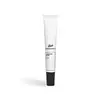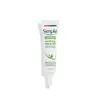What's inside
What's inside
 Key Ingredients
Key Ingredients

 Benefits
Benefits

 Concerns
Concerns

 Ingredients Side-by-side
Ingredients Side-by-side

Water
Skin ConditioningCaprylic/Capric Triglyceride
MaskingButylene Glycol
HumectantGlycerin
HumectantPEG-100 Stearate
Glyceryl Stearate
EmollientButyrospermum Parkii Butter
Skin ConditioningDimethicone
EmollientSiloxanetriol Alginate
Skin ConditioningCarbomer
Emulsion StabilisingPhenoxyethanol
PreservativeMethylparaben
PreservativeSodium Hydroxide
BufferingPotassium Cetyl Phosphate
EmulsifyingTocopheryl Acetate
AntioxidantEthylhexylglycerin
Skin ConditioningChlorphenesin
AntimicrobialXanthan Gum
EmulsifyingCaffeine
Skin ConditioningSodium Hyaluronate
HumectantDisodium EDTA
Sodium Methylparaben
PreservativeSorbic Acid
PreservativePropylparaben
PreservativeWater, Caprylic/Capric Triglyceride, Butylene Glycol, Glycerin, PEG-100 Stearate, Glyceryl Stearate, Butyrospermum Parkii Butter, Dimethicone, Siloxanetriol Alginate, Carbomer, Phenoxyethanol, Methylparaben, Sodium Hydroxide, Potassium Cetyl Phosphate, Tocopheryl Acetate, Ethylhexylglycerin, Chlorphenesin, Xanthan Gum, Caffeine, Sodium Hyaluronate, Disodium EDTA, Sodium Methylparaben, Sorbic Acid, Propylparaben
Water
Skin ConditioningPEG-100 Stearate
Glyceryl Stearate
EmollientButyrospermum Parkii Butter
Skin ConditioningCyclopentasiloxane
EmollientBisabolol
MaskingC13-14 Isoparaffin
EmollientCaprylyl Glycol
EmollientCetearyl Alcohol
EmollientLaureth-7
EmulsifyingPanthenol
Skin ConditioningPantolactone
HumectantPhenoxyethanol
PreservativePolyacrylamide
Simmondsia Chinensis Seed Oil
EmollientSodium Hyaluronate
HumectantTocopheryl Acetate
AntioxidantIngredients Explained
These ingredients are found in both products.
Ingredients higher up in an ingredient list are typically present in a larger amount.
This ingredient is also known as shea butter. It is an effective skin hydrator and emollient.
Emollients help soothe and soften your skin. It does this by creating a protective film on your skin. This barrier helps trap moisture and keeps your skin hydrated. Emollients may be effective at treating dry or itchy skin.
Shea butter is rich in antioxidants. Antioxidants help fight free-radicals, or molecules that may harm the body. It is also full of fatty acids including stearic acid and linoleic acid. These acids help replenish the skin and keep skin moisturized.
While Shea Butter has an SPF rating of about 3-4, it is not a sunscreen replacement.
Shea butter may not be fungal acne safe. We recommend speaking with a professional if you have any concerns.
Learn more about Butyrospermum Parkii ButterGlyceryl Stearate is a mix of glycerin and stearic acid.
It is used to stabilize the mixing of water and oil ingredients. By preventing these ingredients from separating, it can help elongate shelf life. It can also help thicken the product's texture.
As an emollient, it helps soften skin and supports barrier-replenishing ingredients.
In cosmetics, Glyceryl Stearate is often made from vegetable oils or synthetically produced.
This ingredient may not be fungal-acne safe
Fun fact: The human body also creates Glyceryl Stearate naturally.
Learn more about Glyceryl StearatePeg-100 Stearate is an emollient and emulsifier. As an emollient, it helps keep skin soft by trapping moisture in. On the other hand, emulsifiers help prevent oil and water from separating in a product.
PEGS are a hydrophilic polyether compound . There are 100 ethylene oxide monomers in Peg-100 Stearate. Peg-100 Stearate is polyethylene glycol ester of stearic acid.
Phenoxyethanol is a preservative that has germicide, antimicrobial, and aromatic properties. Studies show that phenoxyethanol can prevent microbial growth. By itself, it has a scent that is similar to that of a rose.
It's often used in formulations along with Caprylyl Glycol to preserve the shelf life of products.
Sodium Hyaluronate is hyaluronic acid's salt form. It is commonly derived from the sodium salt of hyaluronic acid.
Like hyaluronic acid, it is great at holding water and acts as a humectant. This makes it a great skin hydrating ingredient.
Sodium Hyaluronate is naturally occurring in our bodies and is mostly found in eye fluid and joints.
These are some other common types of Hyaluronic Acid:
Learn more about Sodium HyaluronateTocopheryl Acetate is AKA Vitamin E. It is an antioxidant and protects your skin from free radicals. Free radicals damage the skin by breaking down collagen.
One study found using Tocopheryl Acetate with Vitamin C decreased the number of sunburned cells.
Tocopheryl Acetate is commonly found in both skincare and dietary supplements.
Learn more about Tocopheryl AcetateWater. It's the most common cosmetic ingredient of all. You'll usually see it at the top of ingredient lists, meaning that it makes up the largest part of the product.
So why is it so popular? Water most often acts as a solvent - this means that it helps dissolve other ingredients into the formulation.
You'll also recognize water as that liquid we all need to stay alive. If you see this, drink a glass of water. Stay hydrated!
Learn more about Water